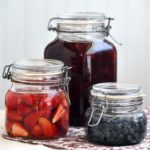Simple Fermented Fruit
Fermenting fruit is a great way to preserve the delicious flavors of summer. It is perfect with any combination of berries or soft fruit. See the section above for sweet and savory serving options.
- Prep Time: 10 minutes
- Total Time: 10 minutes
- Yield: 2 cups 1x
- Category: Dessert
- Method: Fermented
- Diet: Vegan
Ingredients
Scale
- 2 cups of fresh fruit or berries (no bruises or bad spots)
- 2 Tbsp of starter culture (see notes for some suggestions)
- Water, enough to cover (chlorine-free)
- 1 Tbsp raw sugar (optional, to feed the ferment)
Instructions
- Wash and prepare the fruit. If you are using stone fruit then you need to pit and slice them. Large strawberries should be sliced as well.
- Pack the fruit into a glass jar for fermenting.
- Stir in the sugar and culture.
- Add enough filtered water to keep the fruit submerged, leaving at least 1 inch of headroom at the top of the jar.
- Use a weight to keep the fruit below the liquid. Cap with a fermentation-friendly jar lid or a cloth held in place with a jar ring to keep out any fruit flies. It’s going to bubble a lot, so don’t use a tight lid.
- Place the jar in a cool dark location (a cupboard is perfect) to ferment for 2-3 days.
- The fruit will start out “sparkling” but it should mellow out after a few days in the fridge.
- If you want a smooth sauce, without any chunks, then puree after fermenting.
- The fruit will be a lot less sweet than you expect. Even if you used honey as the culture, fermenting consumes most of the sugars. If you want your fruit to be a bit sweeter, stir in sugar or honey right before serving.
- Store the fruit in the fridge and enjoy them within 2 weeks. See the section above for details on how to preserve fermented fruit for winter eating.
Notes
- The natural sugars in the fruit will ferment with any yeast-based culture. Try using water kefir, kombucha, milk kefir whey, or ginger bug. Raw apple cider vinegar is perfect for a savory ferment. My favorite culture is raw (unpasteurized) honey which naturally ferments into a sweet, then savory combination.
- I usually ferment in a straight-sided 500 ml mason jar
which makes it easy to freeze them after fermenting. Regardless it’s important to keep the fruit below the liquid because there is an added risk of mold contamination with a sweet ferment.
Find it online: https://www.fermentingforfoodies.com/fermented-berry-sauce/
